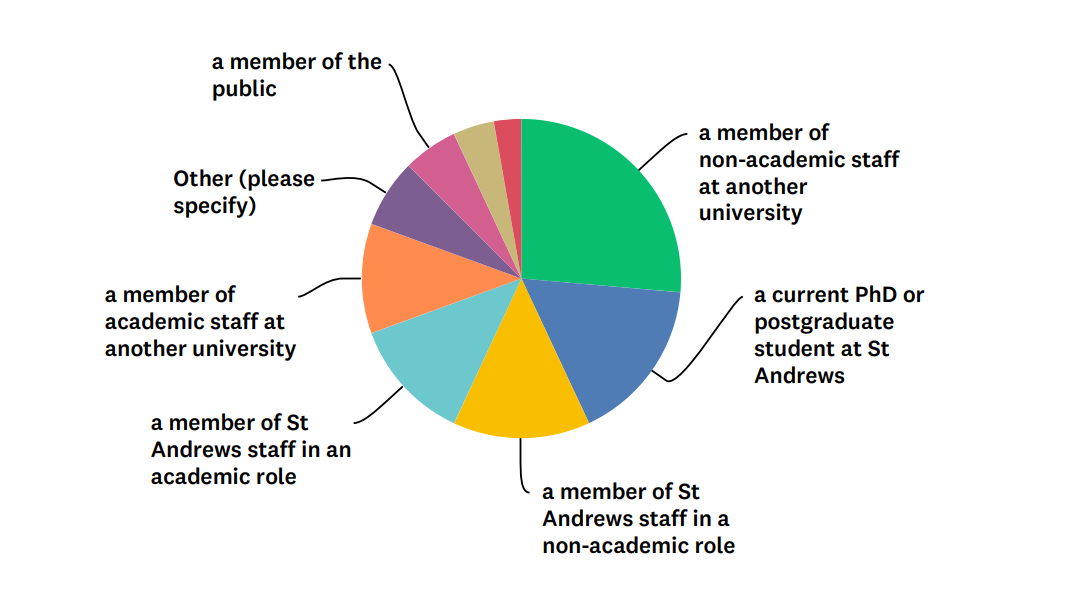Our research survey says…
In order to inform the design of the new University of St Andrews research section, the digital communications team wanted to establish what the top tasks were for users of the current research website. We did this by using a survey, the results of which can be found below.
The survey
The survey was also an opportunity for the team to gauge contextual information about users such as:
- who uses the research site
- their opinion on the design and content on the research site
- what other research-orientated sites they use.
The survey was run from Thursday 29 March to Tuesday 17 April 2018, and in that time it amassed 72 responses. Of the 72 respondents, responses were generally balanced across different audiences. As as standalone audience, responses from members of non-academic staff at another university were slightly higher than the rest. This is likely due to the survey being shared with members of Scottish Web Folk, a group aimed at professionals working in Scottish higher education.
However, combining the numbers of responses from those who attend the University of St Andrews in any capacity (a current PhD or postgraduate, a member of staff in non-academic role and academic staff) results in the highest ‘turn out’ in comparison (53%).
Participants were asked what their top tasks were and what they would improve about the St Andrews research website if they used it. All users were also asked to provide examples of external research-orientated websites that they have visited for additional research news and information.
Key findings
On average, survey respondents in general felt that the research website was “badly organised” and was out of date in terms of content and design. When asked how they would improve the website, respondents recommended:
- fixing broken links
- updating content and design
- promoting specific research.
Top tasks
The main findings from the top task questions was that the majority of users used the research site to contact a member of staff.
For the participants who answered a multiple choice question on top tasks, over 50% selected ‘Contact a member of staff’.
The overall top tasks reported using the research website for were:
- Contacting a member of staff
- Finding a specific researcher
- Finding staff who are working in the same research area
- Finding research news
- See recent publications of specific colleagues / researchers.
The two largest respondent audiences were members of staff at another university and members of staff at the University of St Andrews (together totalling 53% of the survey’s respondents). For both audiences, the primary use of the research site was to find contact information for members of staff and researchers.
Statistics
One finding from initial stakeholder engagement with internal researchers at the University was that they wanted to see a greater emphasis on some of the key research statistics relating to St Andrews. They suggested that the research homepage or showcase page should ‘wow’ users and paint a picture of the high quality research that happens at the University. Question eight was created as a response to this to gauge what sort of headlines people are interested in.
When participants were asked to consider what type of statistics would improve the impression of the University, there were common themes in their responses. Users suggested statistics which included the following themes:
- Numbers – e.g. “50 out of 55” and “9/10”
- Personal – e.g. a member of staff is mentioned by name
- Money – e.g. funding opportunities and “11bn”
- Key terminology – e.g. a specific research area such as cancer and “laser research”.
Following this, when we create the showcase homepage and any statistics for it, we will aim to create them using some of the themes listed above.
Finding research information
Two questions asked users about any other websites they use to find information regarding St Andrews-specific research and what they use other research orientated websites for.
When users don’t use the university website, there are three main areas users go to find out St Andrews research news:
- External sources such as Google, JStor and social media (52%)
- University of St Andrews School / Department / Unit / Centre website (28%)
- University of St Andrews main site, such as the News section, internal emails and Pure profiles. (20%).
When asked what other external websites are used to find out about more general research news, findings showed that users tended to complete the following tasks on external, research-oriented websites:
- Browsing: finding research news
- Social: ‘academic linkedin’. networking
- Research: funding opportunities, fact checking, competitor research.
Due to the quantitative nature of a survey, we recognise that the data provided by 72 respondents may not be as robust as data from a larger pool of respondents. However, it is hoped that the new design of the research homepage to include clearer navigation and links to sections such as research showcase will improve general user experience and help alleviate many of the issues raised by respondents.
Next steps
The next steps for digicomms will be to use this initial data to help create a prototype homepage for the research section. We know that it should include large links to contact information, the research portal and the showcase section. We plan to meet with key stakeholders from the University’s Research Innovation Services within the next week to complete a design sprint to come up with some potential design ideas.
TL:DR?
Respondents thought that the current research site was poorly organised and their main reason for using the site in the first place was to find someone’s contact information. As a result of this, we are going to ensure users can easily contact a member of staff or a researcher.

